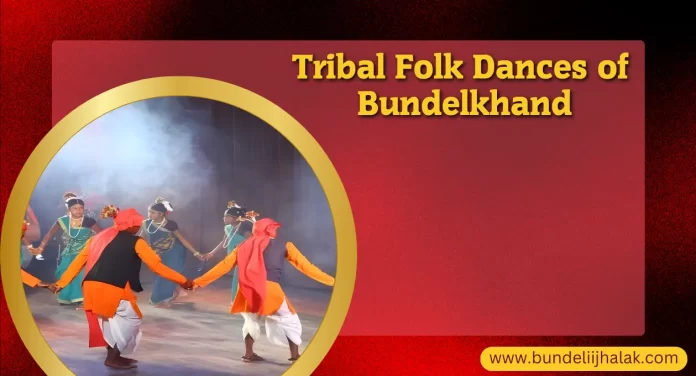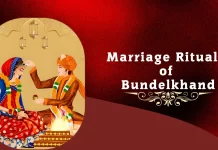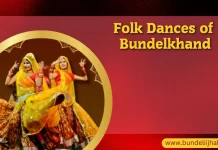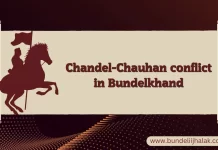The folk dances of the tribals are spontaneous. Tribal Folk Dances learn dance in the environment of nature. They got inspiration from the company of nature to line up with the birds flying in the sky, to make a circle with the water waves rising due to the gusts of wind, to bring flexibility in the dance with the swaying of the forest grass, to dance in groups with the trees and bushes of the forest and to dance with the dances of the peacock. From this point of view, the folk dances of the tribals are a gift of nature. The main tribals of Bundelkhand are Gond and Saur (Sahariya), who are skilled in folk dances. Their main folk dances are as follows.
Karma Dance
Karma is the most favourite dance of the tribals, which is performed on the occasions of joyful moments like marriage, fair etc. Male and female dancers wear undergarments above the knees and put peacock feathers on their heads. Two or three men play the main instrument Mandar and Nagdiya comes in the category of supporting instrument.
There are 7 to 16 female dancers and 8-10 male dancers stand facing the women. The dance begins with the lyrics of the song (Ho Ho Re O Ho Hum Re Ga Aay Hay Hay Ho Re). The rows of female and male dancers standing face to face dance with their hands around each other’s waists. First of all, a branch of the Kadamba tree is planted in the middle, then the Karma dance is performed around it. The square is covered with cow dung near that branch.
At night, the girls who observe fast, after taking a bath, fill water in new pots from the reservoir and keep them near the same branch. Lighted lamps are kept on the pots. The priest comes and performs the puja. After this, the dance takes place.
This dance goes on all night in winter, but not in the rain. This dance is about the belief in creation, karma and the will to live, because of this, collective coordination of stepping is essential and the beauty of the dance lies in that. The male dancers dance by bending, rising and swaying to show the harmony of body movements. When the female dancers move forward, the male dancers move backwards and when the male dancers move forward, the female dancers move backwards. Stepping is very important in the dance because the dance depends on it.
Early in the morning, the priest uproots a branch and moves forward and the village folk follow him performing dances. On reaching the pond, they bury the branch in the ground and dance near it. Before sunrise, the branch and the pitchers are immersed in water.
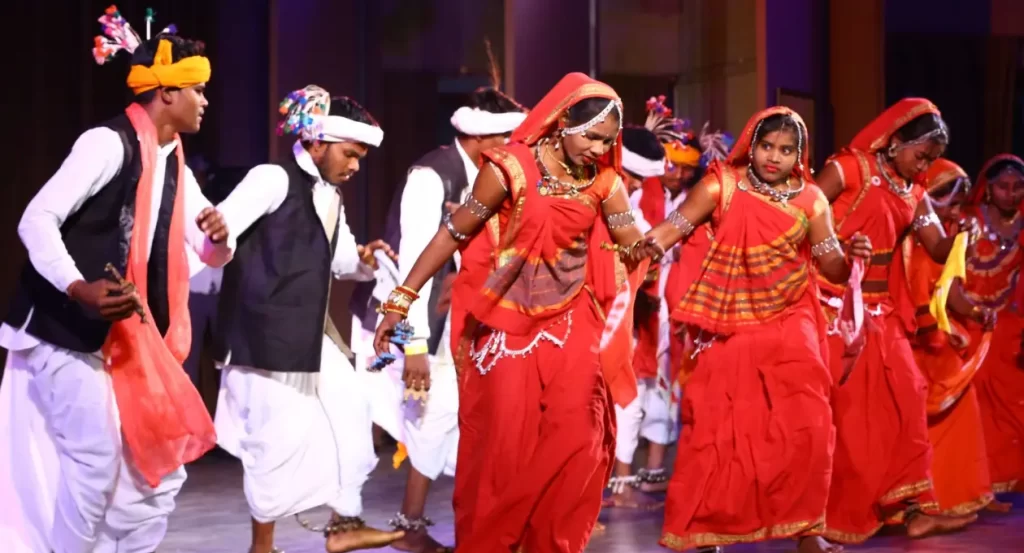
Tribals celebrate Karma in three parts-
(1) Karma Teeja– It is celebrated on Kwar Masaki Teej, only unmarried girls participate in it.
(2) Karma Ekadashi– It is celebrated on Kwar Masaki Gyaras, only unmarried girls and boys participate in it.
(3) Karma Jitiya– It is celebrated twelve days after Kwar Masaki Gyaras, everyone participates in it.
The purpose of Karma dance is not only entertainment, but also a feeling of well-being and well-being for all the people of the village. Karma can be divided into two parts-one is ritualistic Karma, which is sung and danced in the north-eastern region of Madhya Pradesh. In it, worship is the main and essential, song and dance are secondary.
Karma song and dance are also prominent in the central and southern parts of Madhya Pradesh. In the first, Karma is a festival for vows and the prestige of karma, and in the second, it is for entertainment. In Karma songs, family matters, poverty, lack of resources, inflation, etc. problems, economic and social aspects, business aspects, religious aspects etc. have been reflected and the entire life has been made a prestige act.
Saila Dance
Saila dance is a male dance of the tribals, in which small sticks, a symbol of manliness, are played in both the hands of the dancers. This dance is performed on occasions like marriage, fairs etc. and sometimes becomes a medium of competition between two groups. In this dance, male dancers wear dhoti up to the knees and put peacock feathers on their heads, while female dancers wear saree up to the knees covering the chest. Among the instruments, Mandar, Dhol and Nagariya are the main ones.
At the beginning of the dance, songs with short verses are sung. The dancers stand in a circle and move two-three steps forward and play both the sticks twice, then move back and play sticks with the dancers on either side of them. In this way, the dancers complete their cycle by moving around in their place, sitting down and dancing swayingly while hitting sticks against each other. The dance reaches its speed on the beats of the Mandar and the Dhol and the sound of the sticks hitting it starts sounding melodious. The dance ends on the rhythm of the song.
तर हर नाना तरिहा रे तरिहरि है नाना।
कारबर डेरा डीह डोगर, कारबल कोइल कछार,
कारबर है अमरइया, काबर पभर दुबारा,
सिंहा के डेरा अमरइया, डेरिहा परम दुआर।
A singer starts a song and everyone repeats it. When Saila dancers go to other villages and dance, it is called Girda dance. Girda dance is an inter-village dance, on this basis it is proved that villages were connected through folk dance. Just as the Mouniyas go to 12 villages and dance, in the same way Saila dance is a remedy for the national problem and welcomes you.
Dances of Gonds Bhadouni, Kaharwa and Sajni are the main dances of Gonds. Bhadouni is a wedding dance, in which the baraatis are abused by singing songs and women dance on the singing of songs. The baraatis pay for the abuses. Kaharwa is both a song and a dance.
In a wedding, after the Bhawar, the men and women of the baraati sing and dance the Kaharwa song and the groom’s father, uncle etc. make sacrifices. Sajni dance is of the time when the in-laws come to send the girl off. Guests are seated in the courtyard and dancers dance with singers and musicians. The Samdhin of the house dances with her Samdhin. This dance continues throughout the night.
The two main folk dances of Sonar or Sahriyas are Lehangi and Duldul Ghodi. Lehangi is the folk dance of the rainy season, which is performed from Ashadh to Bhadon. The songs ‘Chaika and Chapai’ are sung as lyrics of this dance and Lehangi dance is performed in different postures with a stick.
The coordination of the steps and music of the dance is appropriate and attractive. The second dance is Duldul Ghodi, which is performed on occasions of childbirth, marriage, Navdevi and fairs. In this, the main dance is a man who dances as a horse rider, who wears female attire. There is a jester to make the audience laugh and to taunt them with satire. Poems or songs are also sung in this dance. In this, folk instruments like Digga, Tamodi, Maskak and Jhinkha accompaniment is done.
संदर्भ
बुंदेली लोक साहित्य परंपरा और इतिहास – डॉ. नर्मदा प्रसाद गुप्त
बुंदेली लोक संस्कृति और साहित्य – डॉ. नर्मदा प्रसाद गुप्त
बुन्देलखंड की संस्कृति और साहित्य – श्री राम चरण हयारण “मित्र”
बुन्देलखंड दर्शन – मोतीलाल त्रिपाठी “अशांत”
बुंदेली लोक काव्य – डॉ. बलभद्र तिवारी
बुंदेली काव्य परंपरा – डॉ. बलभद्र तिवारी
बुन्देली का भाषाशास्त्रीय अध्ययन -रामेश्वर प्रसाद अग्रवाल
